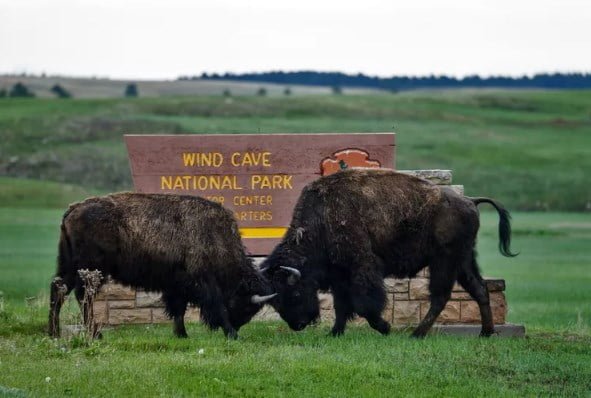Wind Cave National Park in the Black Hills of South Dakota is the world’s largest and foremost example of a box work cave containing honeycomb-like calcite formations in the cave. It is currently the sixth-longest-mapped cave in the world and the third-longest in the U.S.
The cave, sacred to the Lakota tribe of Native Americans, is called Wind Cave because of the wind that naturally blows out of the natural entrance to the cave, which occurs when the barometric pressure inside the cave exceeds the air pressure outside. In Lakota, it’s called Maka Oniye, meaning “breathing earth.” Lakota’s oral tradition tells the story of humankind first emerging from the natural entrance to Wind Cave after living below the earth to live on the surface. You can discover the entire Emergence Story here.
To enter the cave, you must be on a ranger-led tour, reserved in person at the Visitor’s Center on the day of the tour.

Above the cave is more than 28,000 acres of prairie and pine forest with more than 30 miles of hiking trails. There are also several driving routes. You can spot various wildlife species inside the park, including bison, elk, cougars, pronghorn antelopes, ferrets, prairie dogs, bobcats, and rattlesnakes.
Things to Do
Touring the cave and exploring the surrounding prairie and forest are the main draws to Wind Cave National Park, which is open throughout the year. In warmer weather, hiking is very popular on the trails, which range in length and difficulty, as is getting on a ranger-led cave tour. However, there are often long waits during the spring, summer, and fall seasons, so arrive as early as possible. There are still cave tours in the winter, although there are fewer tours per day. The cave is a constant 54 degrees Fahrenheit, so it can be a great place to warm up. Visitors can also go snow-shoeing on the trails and see plenty of wildlife in winter.
Wildlife watching for bison herds and seeing prairie dogs in their prairie dog towns is also popular. In September and October, you can listen to bugling elk when male elk try to attract a mate by emitting a haunting bugle sound.
Back-country camping without reservations is allowed at Wind Cave, and there are numerous picnic tables and grassy areas to gather. Visitors can also drive the self-guided 20-mile geology route with an audio tour, which shares the geologic history of Wind Cave National Park. Road biking on established paths and horseback riding are also allowed inside the park but note that there are no facilities to rent equipment or horses.
Best Hikes and Trails
Wind Cave National Park has more than 30 miles of hiking trails with varying difficulty levels. Most of the trails are easy or moderate and can be completed by adults and kids, although you should expect some steep climbs on specific trails. Wind Cave is also an open hike park, and visitors are welcome to hike off marked trails. If you decide to hike away from established trails, bring plenty of water and a map, and be aware of your surroundings at all times. Wherever you hike, wear sturdy shoes, apply sunscreen, carry water, and wear long sleeves and long pants to avoid ticks and poison ivy when hiking.
Pets are allowed on two trails near the Visitor’s Center (Prairie Vista Trail and Elk Mountain Campground Trail), each about a mile long.

Elk Mountain: An easy loop trail that measures 1.2 miles and winds around the Elk Mountain Campground and the surrounding prairie grasslands. The trailhead starts at the Visitor’s Center.
Cold Brook Canyon: A 1.4-mile one-way moderate trail with an initial descent that drops into the canyon. Visitors will hike through a ponderosa forest, open prairie, and a prairie dog town where prairie dogs, falcons, and other raptors nesting along the cliffs can be seen. The trailhead is along Route 385, about 1 mile south of the Visitor’s Center.
Rankin Ridge: To find this trail, follow Highway 87 toward Custer State Park, and look for signage leading toward Rankin Ridge Nature Trail. It’s at the highest point in the park and affords spectacular views, yet it’s an easy 1-mile loop.
Wind Cave Canyon: Wind Cave Canyon trail is a former road that follows Wind Cave Canyon to the park boundary for 1.8 miles. The limestone cliffs provide nesting areas for cliff swallows, canyon wrens, and great horned owls.
Sanctuary: The 3.6-mile Sanctuary trail is rated difficult. It follows a rolling prairie and crosses a large prairie dog town. The trail ends where it meets the Highland Creek Trail, the longest trail in the park.
Highland Creek: To reach Highland Creek, hike 1 mile down the Wind Cave Canyon trail or start from the northern trailhead on NPS 5. The trail is 8.6 miles one way and is the most diverse trail in Wind Cave. The hike traverses prairies, ponderosa forests, and riparian habitats along Highland and Beaver Creeks and the Wind Cave Canyon.
Boland Ridge: Boland Ridge is a strenuous 2.6-mile hike with panoramic views of the Black Hills to the west and the Great Plains to the east. Look out for elk in the morning and evening.
Lookout Point: A moderate 2.2-mile hike, Lookout Point follows the rolling hills of the prairie and descends to Beaver Creek. Views of the American Elk Prescribed Fire can be seen on a side trip up to Lookout Point. Turn this hike into a 4.5-mile loop by combining it with part of the Highland Creek and Centennial trails.
Where to Camp
Wind Cave National Park has one campground and allows backcountry camping in a specific area.
Elk Mountain Campground: This is a year-round 62-site campground that operates on a first-come, first-serve basis. Two sites are handicap-accessible. Flush toilets and drinking water are available from late spring through early fall, and vault toilets are available year-round. Firewood is for sale year-round. During summer, ranger programs are offered nightly in the amphitheater.
Backcountry camping: Backcountry camping is allowed in the northwest area of the park with a free permit. Free permits are issued at the Visitor’s Center and come with instructions about backcountry camping in the park. The permit area includes the part of the park that is north of Beaver Creek, east of Hwy 87, south of NPS 5, and west of Highland Creek Trail.
Custer State Park: There are numerous campgrounds in nearby Custer State Park, which borders Wind Cave National Park to the north.
How to Get There
The entrance to Wind Cave National Park is on U.S. Hwy 385, 11 miles north of Hot Springs and 22 miles south of Custer. Once inside the park, follow signs to the Visitor’s Center, where all cave tours begin. Parking is available at the Visitor’s Center. There is no public transit to the park.
Accessibility
Accessible cave tours and special arrangements are available for those with limited mobility, vision, and hearing. Otherwise, all cave tours include walking, standing, bending, stooping, and climbing stairs.
However, limited cave areas are accessible to wheelchairs and those with limited mobility. The park offers special half-hour accessibility where visitors can get an introduction to the cave and box work, the cave’s signature feature. This tour includes riding the elevator into and out of the cave, and accessible parking is available at the elevator building. To arrange an accessible tour, call the visitor center at (605) 745-4600, or ask at the information desk for an Accessible Tour.
Cave trails are dimly lit, often narrow, with many stairs, and may be wet and slippery in certain areas. Persons with vision impairments should be cautious when entering the cave; bringing an extra flashlight may help.
For those with hearing impairments, sign-language programming can be arranged in advance if the park is contacted at least two weeks ahead of time to arrange accommodations.
Visitors in wheelchairs can view the cave’s natural entrance, accessible via a ramp and sidewalk from the Visitor’s Center or a flat trail that starts at the picnic area.
The Visitor’s Center is accessible to wheelchairs and those with limited mobility, and an elevator is available between floors.
There are two wheelchair-accessible campsites, B2 and D3, at the Elk Mountain Campground.
Tips for Your Visit
Entrance to the park is free, but tours of the cave range in admission from $10 to $12 for adults and $5 to $6 for children and seniors.
Cave access is by a ranger-guided tour from the Visitor’s Center only. Tickets are first-come, first-serve on the day of the tour, so during spring, summer, and fall, it’s best to get in line by 6:30 a.m. to secure tickets. Tours often sell out by mid-day.
There are three tours offered: the Garden of Eden Tour (1 hour), the Natural Entrance Tour (1 hour 15 minutes), and the Fairgrounds Tour (1 hour 30 minutes), which has the most stairs and is the most strenuous.
All cave tours (except special accessibility tours) involve walking up and down stairs and occasional low ceilings. Cave tours are not recommended for anyone with claustrophobia, heart or respiratory conditions, recent surgeries or illnesses, knee or back problems, or other physical limitations.
The cave is a constant 54 degrees Fahrenheit, so wear long sleeves and bring a jacket.
It’s essential to be aware of the large wildlife that roam in the park above the caves, including bison and mountain lions. Visitors must stay at least 25 yards from all wildlife, although it is strongly recommended to stay farther away from bison, which may appear tame but are unpredictable and can charge without warning.
